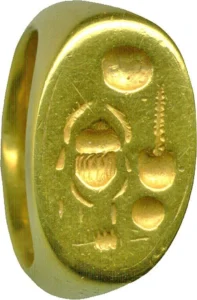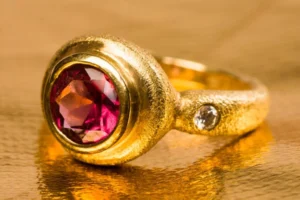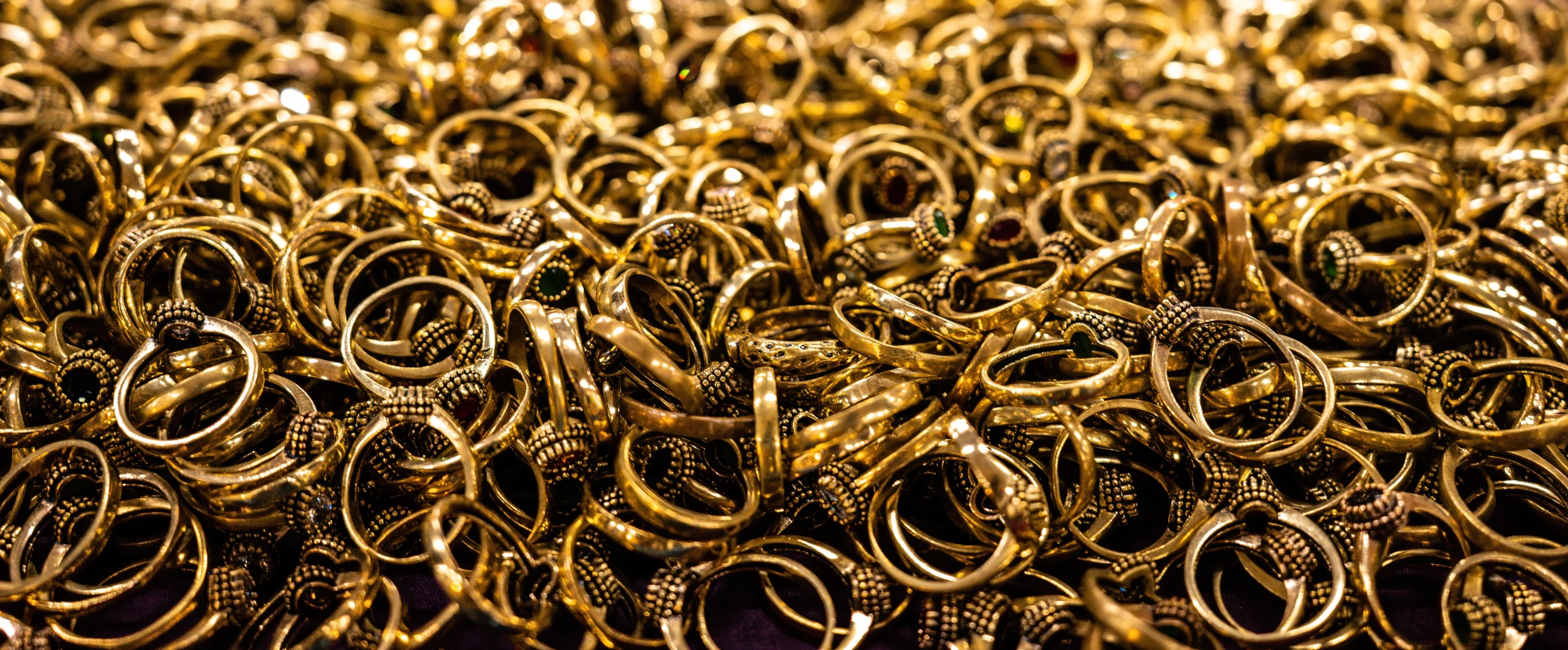
Perhaps the most ubiquitous form of jewelry in the world, gold rings have been worn for millennia, serving many purposes beyond mere adornment. From religious worship and romantic gestures to honoring the dead, gold rings have carried profound meaning across cultures and time periods.
Modern gold jewelry is mainly worn as decoration, but this wasn’t always the case. Gold signet rings, for example, were used in ancient civilizations such as Egypt and Mesopotamia to create personal signatures on items like letters and documents. These rings featured flat surfaces that were engraved with unique designs, like a family crests or initials. People would press the engravings into hot wax or soft clay to leave a custom marking. Talk about functional fashion!
Meaning and history aside, gold rings are inherently valuable – especially in today’s market with soaring gold prices. Read on for tips on how to spot fake gold, identify different ring types, estimate value and more.
How Can You Tell if a Ring is Real Gold?
If you have a gold ring and are unsure whether it’s real or not, start by looking for production hallmarks and karat stamps. If you’re lucky enough to have a solid gold alloy, there should be a karat stamp on the ring. All solid gold jewelry that’s 10k or higher is required by law to bear a karat stamp, thanks to the 1906 National Gold and Silver Marking Act. However, some homemade pieces may not be marked.
Home Gold Tests
There are a few simple methods you can try to test for real gold, but keep in mind that none of them are 100% definitive. Gold rings are rarely pure, as pure gold is too soft for daily wear – so we need to account for the other metals in the alloy. These added base metals, like nickel, iron and cobalt, can skew the results of home tests. For instance, nickel is magnetic, so if you’re testing a 14k gold ring that also contains nickel by using the magnet test, the ring might appear fake even though it’s authentic.
Although they’re not always conclusive, it doesn’t hurt to give home tests a try. Here are a few easy methods that won’t damage your jewelry:
- Float test: Drop your ring into a glass of water. If it floats, it’s definitely fake gold. If it sinks, it may be real gold, but further testing is needed.
- Skin test: Hold the ring between your fingers for a few minutes to see if it reacts with your skin. Real gold won’t create any discoloration. Fake gold could leave green, black, or blue marks.
- Magnet test: Again – this is not the most reliable method, but if you still want to try it just for fun, go for it! Find a strong magnet and hold it next to your ring. If the ring clings to the magnet, you either have fake gold or a gold alloy that contains another magnetic metal (such as iron or nickel).
Do Gold Rings Tarnish?
Gold is a remarkable ring-crafting material for several reasons. One of its best qualities is resistance to tarnishing. A high-quality gold ring will not tarnish and can last several lifetimes!
Gold is also extremely malleable, allowing for tons of intricate design possibilities. Last but not least, it’s hypoallergenic. While some cheaper metals are known to cause skin irritation, gold is skin-friendly.
Gold Ring Karat Ratings
Gold is a soft metal, which is why pure gold rings are rare – they’re simply too fragile for daily wear. To improve durability, gold is combined with other metals like silver, copper, nickel, and zinc. A well-made gold alloy still retains many of gold’s best qualities, such as its resistance to tarnish and, depending on the metals used, its hypoallergenic properties.
When it comes to gold alloys, 14k, 18k, 20k and 22k are the most common karat ratings. Karats are a measure of purity in gold jewelry, with 24k being pure gold:
- 10k = 41.7% gold
- 14k = 58.3% gold
- 18k = 75% gold
- 22k = 91.7% gold
- 24k = pure gold
Different Types of Gold Rings
Aside from karat levels, it’s important to know the differences between various types of gold rings. A 14k gold-plated ring, for example, contains much less gold than a 14k solid gold ring!
- Gold-plated: A thin layer of gold is plated on top of another metal (often brass)
- Gold-filled: A step up in quality from gold-plated, a layer of at least 10k gold is attached to a base metal
- Gold vermeil: A coating of gold is attached to a base of sterling silver
- Solid gold: No plating or coating on top of a base metal – the entire ring consists of a gold alloy

How Much is a Gold Ring Worth?
The value of gold jewelry is a bit nuanced, as there are several different ways to measure a piece’s worth. For example, a rare and/or antique gold ring may have a high resale value. This value is subjective, driven by how much jewelry connoisseurs are willing to pay for a unique item. Sentimental value is also important – it’s hard to put a price on a precious family heirloom.
On the other hand, scrap value or ‘scrap metal value’ is more clear-cut. This simply refers to the value of the precious metals in the ring. A gold ring’s scrap value is determined by the amount of gold it contains and the market price of gold. To roughly estimate a gold ring’s value, you can use the karat level, the weight of the item, and gold’s current spot price.
Verifying A Gold Ring’s Purity
Remember: while karat markings are great clues to indicate purity, they’re never fully guaranteed. It’s impossible to truly confirm a ring’s gold content and value without performing an assay, which is a metallurgical procedure performed at a precious metals refinery.
If you’re simply wondering about gold content for the sake of selling your gold ring, sending it to a refinery is the best way to assess the material and get the highest value!
Selling Gold Rings
There are many places to sell gold jewelry, but not all gold buyers are created equal. If you have a rare or antique piece, it’s probably worth getting a jewelry appraisal. You may also want to explore auction houses and consignment options.
Otherwise, if you have gold jewelry that’s broken, damaged or simply not your style, selling it a reputable precious metals refinery will ensure the highest possible payment for your item’s scrap value.
Beware of any gold buyer that uses the “weigh and pay” method to calculate your payment. This approach only considers the weight of your gold and ignores the precise metal composition, meaning you could miss out on the full value of your items.
Moreover, non-refinery buyers act as intermediaries, building their own fees into your payment – they’ll eventually sell your gold to a refinery and pocket the difference. To avoid these hidden fees, sell your gold to a trustworthy refinery. Garfield Refining, for example, has trusted by jewelers, pawnbrokers, dentists and individual sellers since 1892!
Stay tuned to our blog to learn more about gold jewelry! If you enjoyed this post, you may also like ‘What is White Gold?’ or ‘Top 5 Sustainable Gold Jewelry Brands.’
Do you have gold jewelry scrap that you’re looking to sell? Look no further than Garfield, your precious metals experts since 1892! Get started today with a free, fully-insured shipping label.

